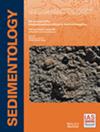海底化学在黑海甲烷渗漏处纤维镁方解石形成中的作用
IF 2.8
2区 地球科学
Q1 GEOLOGY
引用次数: 0
摘要
气候变化对地球上的生命构成了重大挑战。不同的气候模式伴随着海水镁/钙(Mg/Ca)比的变化,这种变化被认为控制着海洋自生碳酸盐的初级矿物阶段。然而,除了海水Mg/Ca比外,还存在控制海相碳酸盐相的因素。在黑海甲烷渗漏处形成的纤维状胶结物为纤维状碳酸盐的元素和矿物相组成的控制因素提供了新的见解。在这项研究中,文石和纤维状镁方解石胶结物在黑海三个渗漏点的分布被描述为水深的函数。海水和浅层孔隙水的Mg/Ca比值均接近4。纤维状镁方解石在深度为120 ~ 190 m的浅水渗碳酸盐中晚于文石胶结物,而镁方解石是深度大于2000 m的唯一胶结物。纤维状镁方解石在阴极发光下呈带状分布,晶体形态符合竞争生长,MgCO3含量均匀分布,δ18O值计算的局部条件下沉淀平衡,证实了镁方解石的初级形成。MgCO3含量(4.5 ~ 12.2 mol%)与δ13C值呈负相关,表明甲烷厌氧氧化产生高浓度硫化物有利于Mg进入方解石晶体结构。与开阔的海洋盆地不同,黑海的分层作用导致深层水柱的缺氧条件,有利于纤维状镁方解石的形成。这一观察结果与硫化物催化作用是在高Mg/Ca比下形成低Mg方解石到非常高Mg方解石的关键因素相一致,并且可能与海洋缺氧时期碳酸盐胶结物的形成有关。本文章由计算机程序翻译,如有差异,请以英文原文为准。
Role of bottom water chemistry in the formation of fibrous magnesium calcite at methane seeps in the Black Sea
Climate change poses a significant challenge for life on Earth. Different climate modes have been shown to come along with changes of the magnesium/calcium (Mg/Ca) ratio of seawater, and such changes are believed to control the primary mineral phase of marine authigenic carbonates. However, factors controlling marine carbonate phases other than seawater Mg/Ca ratios exist. Fibrous cements forming at methane seeps in the Black Sea provide new insight into the factors governing elemental and mineral phase compositions of fibrous carbonates. In this study, the distribution of aragonite and fibrous Mg calcite cements from three seep sites in the Black Sea is described as a function of water depth. The Mg/Ca ratio of seawater, as well as the ratio in shallow pore water, is close to four at the examined sites. Fibrous Mg calcite postdated aragonite cement in seep carbonates from shallow water depth of 120 to 190 m, whereas Mg calcite is the only cement at a greater depth of ca 2000 m. The primary formation of fibrous Mg calcite is confirmed by its zonation under cathodoluminescence, crystal morphologies agreeing with competitive growth, uniformly distributed MgCO3 contents and precipitation in equilibrium with local conditions calculated from δ18O values. The MgCO3 contents (4.5 to 12.2 mol%) are negatively correlated with δ13C values, indicating that the incorporation of Mg into the calcite crystal structure was favoured by high concentrations of sulphide generated by sulphate-driven anaerobic oxidation of methane. Unlike open oceanic basins, stratification in the Black Sea leads to euxinic conditions in the deeper water column, favouring fibrous Mg calcite formation. This observation is consistent with sulphide catalysis as a critical agent for the formation of low-Mg calcite to very high-Mg calcite at high Mg/Ca ratios and is possibly relevant to carbonate cements forming during times of oceanic euxinia.
求助全文
通过发布文献求助,成功后即可免费获取论文全文。
去求助
来源期刊

Sedimentology
地学-地质学
CiteScore
8.20
自引率
11.40%
发文量
94
审稿时长
6-12 weeks
期刊介绍:
The international leader in its field, Sedimentology publishes ground-breaking research from across the spectrum of sedimentology, sedimentary geology and sedimentary geochemistry.
Areas covered include: experimental and theoretical grain transport; sediment fluxes; modern and ancient sedimentary environments; sequence stratigraphy sediment-organism interaction; palaeosoils; diagenesis; stable isotope geochemistry; environmental sedimentology
 求助内容:
求助内容: 应助结果提醒方式:
应助结果提醒方式:


